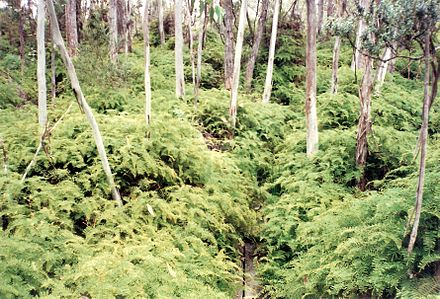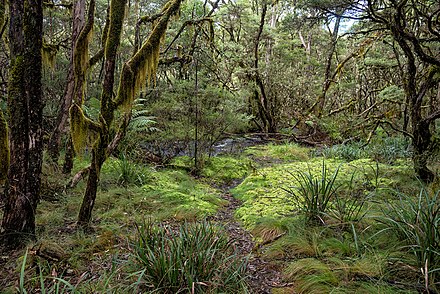New England National Park - national park in Australia
This is about the park in New South Wales. For the region in the northeastern end of the US, see New England New England National Park is a national park in the New England region of New South Wales, part of the many Gondwana Rainforests of Australia and has been a UNESCO world heritage site since 2007.
Understand
History
In the 1920s there was a push to have this area declared a national park. Much of the area was declared a reserve in 1931, dedicated for public recreation in 1935 before coming a national park in 1937. Between 1934 and 1956 mining leases for antimony were granted.
The park was officially opened by the Governor General Lord Gowrie in 1937, but the wilderness area was recognised for its beauty as early as the 1920s.
The park was World Heritage listed in 1986 and forming part of the New England Group of the Gondwana Rainforests of Australia, which was added to the Australian National Heritage List in 2007.
Landscape
Located on the precipitous escarpment on the east of the undulating Northern Tablelands plateau, the wilderness consists of much impressive cliffs, rugged ridges, spurs and streams. To the park's west the Nymboida, Guy Fawkes and Styx Rivers drain across the tablelands and to the park's east is the thickly forested Bellinger River valley.
Flora and fauna
 The park is particularly known for its diverse flora and fauna, having vegetation from sub-tropical, warm temperate and cool temperate rainforests in such a high altitude, but the park also includes areas of sclerophyll forest, sub-alpine woodland, heathland and swampland.
The park is particularly known for its diverse flora and fauna, having vegetation from sub-tropical, warm temperate and cool temperate rainforests in such a high altitude, but the park also includes areas of sclerophyll forest, sub-alpine woodland, heathland and swampland.
Some of the mammals that live in this park are dingos, koalas, tiger quolls, common bentwing bats, brown antechinuses, and northern brown bandicoots.
At least 100 species of birds have been recorded. Larger species include the wedge-tailed eagle, greater sooty owl, sulphur-crested cockatoo and superb lyrebird. Eastern whipbirds, eastern bristlebirds, crimson rosellas, Australian king parrots and several kinds of honeyeaters also inhabit the reserve. Additionally, because the park supports one of five remaining populations of rufous scrub-birds, as well as of flame and pale-yellow robins, paradise riflebirds, green catbirds, regent bowerbirds and Australian logrunners, it has been identifies by BirdLife International as an Important Birding Area (IBA).
Climate
The climate of the park is generally cool all year around, although it can get quite cold during the winter thanks to its high altitude, and you will most likely need no more than a small jacket with you.
Get in
Like most parks in New South Wales, New England National Park is only accessible via car, and so if you don't know how to drive, you're out of luck. If you don't have a car with you, car rental services are available at Coffs Harbour and Armidale, two large regional cities, and make sure that your rental car company allows you to go on unpaved roads, otherwise; you also won't be able to explore the park since the roads to the park are not paved.
From Armidale, take the B78 Waterfall Way east and head for about an hour for around 65 km. Just about 7.6 km before the town of Ebor, and turn onto Point Lookout Rd and continue on for about 15 km to the park. The road is mostly unpaved, but it can still be done with a good 2WD, but the conditions are not suitable for caravans. Smaller 2WDs are also not likely to make it as well, and similar to caravans, the road is not suitable.
From Dorrigo, take the B78 Waterfall Way west and head for about forty five minutes for around 55 km. After about 7.6 km after the town of Ebor, and turn onto Point Lookout Rd and continue on for about 15 km to the park, and then follow signage.
From Coffs Harbour, head south onto the M1 Pacific Motorway down and then exit onto B78 Waterfall Way near Raleigh. Then head west for about 100 km and then follow the same directions given from Dorrigo.
Although there is an entry from Darkwood Road on the eastern end of the park, that route is often slow and doesn't even connect to the other roads of the park.
If you are going using a GPS to get here, don't enter "New England National Park" as it will take you smack bang into the centre of the park. Try entering "Point Lookout" instead, or simply use it up to Ebor and then follow signage from there; it's well signposted.
Fees and permits
As of October 2021, there are no fees for the parks, and no part of the park requires a permit and you're all free to go. Do note though, that this park can close within hours notice if there are bushfires, or if there is a severe risk of bushfires.
Get around
There is only one unpaved road within the park; Point Lookout Road, which only goes as far east as 3.3 km ENE, where almost everything is concentrated in. So while you may have to walk everywhere else, you also don't have the need to since there's not much apart from where the road goes up to.
See
 Given the high altitude of New England National Park, much of its beauty lies in its mountains and the Gondwana Forests. But as with any mountain, it has to come with lookouts, and so much of what's there to see in the park is lookouts.
Given the high altitude of New England National Park, much of its beauty lies in its mountains and the Gondwana Forests. But as with any mountain, it has to come with lookouts, and so much of what's there to see in the park is lookouts.
- Point lookout, Point Lookout Rd, Ebor, -30.4886°, 152.410256°. Perched at an altitude of 1563m, this lookout is a panorama of parts of the Gondwana rainforests of Australia come into reality. Easily accessible, as it's only a 200m walk from the carpark. Since this lookout is located on the second tallest mountain in the region, if you do happen to come here on a clear fine day, there is a good chance you might see the Tasman Sea. 2021-10-22
- Wrights lookout, Wrights Lookout Trail, Comara, -30.507486°, 152.4053°. It is quite a challenge to get to this lookout for most beginner bushwalkers, although it's rather a trivial challenge for most others. But regardless, once you come here, you're on a remnant piece of Ebor Volcano, a now extinct volcano and you'll be looking down at the valleys of the Bellinger River. And not to forget, you're also viewing the ancient Gondwana Rainforests of Australia as well. 2021-10-23
Do
 New England National Park is particularly known for its numerous bushwalking opportunities of all sorts through the Gondwana Rainforests. On the other hand, there are no MTB (mountain bike) trails in the park though.
New England National Park is particularly known for its numerous bushwalking opportunities of all sorts through the Gondwana Rainforests. On the other hand, there are no MTB (mountain bike) trails in the park though.
There are numerous bushwalking trails in the park, which include the Cascades walking track, a 5.7 km loop which takes you down the valleys of the park filled with moss, liverworts and ferns, and should take about 2.5-3.5 hours to do.
Other trails include the Eagles Nest walking track, a 2.2 km walking trail that takes about a 1-2 hours to do, taking you through the snow gum forests, the Wrights lookout walking track, a 3.4 km return trail taking you to Wrights lookout, the Weeping Rock walking track, a 2 km return trail passing through some rocky cliffs, or even the Point lookout walking track, a simple 0.5 km walking track going to Point lookout.
Some of the more scenic trails include the Lyrebird walking track, or the Tea Tree falls walking track, both a beauty in their own right.
Longer walks include the New England Wilderness walk, a 33 km walk that takes about 2-3 days to do, from the western end of the park all the way to the eastern end of the park.
Buy, eat and drink
There are no shops, cafes, restaurants, bars, pubs etc. in New England National Park, and the nearest are in Ebor, which is 19 km from the park via Point Lookout Rd and B78 Waterfall Way.
Sleep
Lodging
- The Chalet, 1316 Point Lookout Road, Ebor (near Lyrebird Walking Track, Brinerville.), -30.492673°, 152.406709°. Check-in: 2PM, check-out: 10AM. Surrounded in the immense Gondwana forest, this is certainly a unique lodge in its own right. You can relax on the verandah, and just watch the lyrebirds just go on, and never get bored of it. Unfortunately, it comes with a cost as it only has one room, and only maximum three guests allowed. 2021-10-22
- The Residence, 1316 Point Lookout Road, Ebor, -30.49235°, 152.406532°. Check-in: 2PM, check-out: 10AM. A larger alternative to The Chalet, having four rooms and being able to accommodate ten people max, and you'll be surrounded by the Gondwana Rainforests on every direction you'll be looking at. The lookouts and walking trails are also nearby. 2021-10-22
- Toms Cabin, 1388 Point Lookout Road, Ebor, -30.496556°, 152.398785°. Check-in: 2PM, check-out: 10AM. A much bushwalkers cabin, this cabin has two rooms and can accomodate up to eight guests, suitable for most and not too far away from most of the trails and lookouts. However, there is no electricity though and you will need to bring food supplies, pots and pans, bed sheets, blankets etc. 2021-10-22
Camping
- Thungutti campground, Tea Tree Falls Walk, Ebor, -30.500481°, 152.387606°. Being the only campground in the park, you'd expect it to be packed – but you could be hardly more wrong if you thought that. Because this campground doesn't get much visitors except during easter where all campgrounds are packed. Has 20 campsites, and has most essentials. Oh and not to forget, you're fully surrounded by eucalyptus trees. 2021-10-22
Backcountry
There are no backcountry sites in New England National Park, and camping can only be done in designated camping areas.
Stay safe
Large parts of the park were severely affected during the 2019-20 bushfires, and some of its impacts can still be seen. Furthermore the 2021 East Coast floods have also affected the park, although not to an extent as the bushfires. While these don't make much big of a threat, do be aware of it.
Much of the park doesn't have coverage at all. If you are going to go anywhere in the park apart from the western end, let someone know, and you're going to the centre of the park alone, carry a satellite phone.
Go next
- Head east onto Waterfall Way and head to Dorrigo National Park or head west onto Waterfall Way and head to Oxley Wild Rivers National Park, both a piece of beauty in their own right
New England National Park
environment.nsw.gov.au/NationalParks/parkHome.aspx?id=N0028New South Wales
Primary administrative division